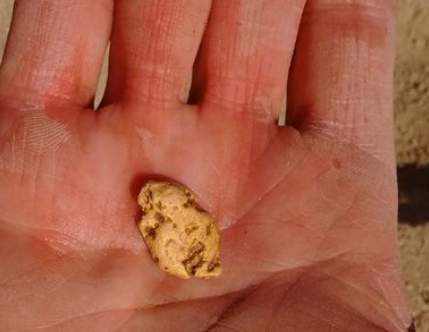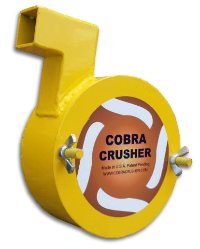Friday, September 30 2022
In an area either rumored or known to hold gold, where should you look first? The creek, the surrounding hills, washouts, or just where? The characteristics of the gold in that area will help you to know where to start. If the gold is flat and pounded, that indicates it’s been in the water a long time. If the gold is coarse and chunky, you know you’re getting closer to the source. When gold is smoother, stop and go back to the coarsest gold and start working upwards until you find the source.
Keep in mind that gold is gold, so there isn’t necessarily a better type of gold. Some is just easier to recover. There are only two types  of gold deposits. The first type is “lode” which is simply everything that is still in the matrix and in the ground, and the other is “placer” —or everything else. of gold deposits. The first type is “lode” which is simply everything that is still in the matrix and in the ground, and the other is “placer” —or everything else.Lode deposits refer to gold that is still locked within its original solid rock formation. This formation of gold generally starts as a vein in rock and is formed over millions of years. Since the gold is locked up in rock, and can be mixed with quartz, calcite, pyrite, and other minerals, lode gold usually requires specialized mining techniques to extract. Lode mining takes a lot more equipment and generally a lot more expense and is usually undertaken by large commercial operations instead of the average prospector. Placer gold is the gold that most prospectors are more familiar with. Placer gold isn’t really any different than lode gold. It is simply a concentration of that same gold that has eroded and traveled away from the vein. Since gold is very dense, it will move downhill much slower than the surrounding sediment. It tends to become concentrated on or near the surface of the lode, forming a “residual placer” close to the original bedrock exposure. Gold found downhill from the immediate outcrop above the nearest watercourse is called an “eluvial placer.” Once it reaches the nearest waterway and is transported by flowing water, the gold now is known as “alluvial placer.” The origin of the dust, flakes and nuggets found by panning and sluicing is usually from a vein up on a nearby mountain. Bench placers were originally stream placers. Benches are simply where the water used to be, maybe even millions of years ago. They are formed by erosion or geological events such as uplifts, earthquakes or plate drops that changed the stream flow. Some of the most profitable mining is performed on benches. Many benches are highly concentrated by the alluvial deposits that still feed them. Stream deposits are the last resting place for gold. Once the gold has been released from the lode, gravity and nature does the rest. And unless gold gets stranded on a bench, it will find its way to the water someday. It may take a million years, but it will get there. When deciding where to begin prospecting, most of the time you’ll want to start panning in a water way, or a wash in the desert where water once flowed. Then let the gold tell you where to go from there. When the gold gets coarse and ragged, start to move up, looking in reverse of how it got to the spot where you found it. In addition to panning and sluicing you may wish to upgrade your mining efforts with a highbanker or power sluice, dredge or trommel. Moving soft soil or river gravel is obviously much easier than breaking rock, but for small scale miners, a rock crusher can pulverize 2 or 3 inch sized rocks into powder in no time. Move more material faster— get more gold! Wednesday, July 23 2014
Wouldn't it be nice if we all had access to geologists, drilling crews, and huge rock crushers to sample hardrock deposits? Well, if that's not in your budget but you still need to determine if an outcropping or vein might be promising before you stake a claim, a portable Cobra Crusher and a few grab samples can work nicely. A grab sample is just that -- randomly chosen rock samples you need to crush and test for gold or other precious metals. Although grab samples can seem counter productive because of the randomness, they can still provide you with a basic, overall understanding of the area and the possibility of higher grade ores in the vicinity. When looking for a grab sample, choose mineralized portions of the vein, pieces of mine dumps near a portal or shaft, or chunks of mineralized float that have broken away from the vein. Mineralized quartz on a mine dump near a mine portal or shaft makes for good grab samples. Often the operators of small mines had to sort and ship only the best of the ore. That means high grade materials can be left behind in mine dumps. What's especially great about the Cobra Crusher is that it's portable and light weight. You don't have to collect and then lug around heavy rocks and wait until you get back home or to your camp to know if they are worth anything. You can crush a few small rocks right in the field, then pan out the powder to see if its gold bearing. Having a small light-weight crusher with you in the field saves guess work. You'll know for sure right there and then if the site you've discovered is worth further consideration. If you don't have water to pan the powder on the spot, crush the rock and store the powder in a plastic bag. Label the bag with GPS coordinates so you know EXACTLY where you got it. Then, after you've panned it later, if you find it contains a good bit of gold, you will know exactly where to return for further testing. It's also helpful to snap a photo of the place where you collected the rock. Matching the GPS coordinates with your photo ensures you'll be able to get back to that exact spot at a later date. In addition to collecting rocks, you might want to take some chip samples from a wide vein. Use a rock hammer to break off small pieces and then run them through the Cobra Crusher. Again, pour the powder into a well labeled bag if you can't pan in the field and can wait until a later time to get the results. When preparing for a sampling expedition, use the information on your local Bureau of Land Management website or in their office. In these files, geologists might have made notes about the specific mines in the area, and/or there will be details about the ore grade, tonnage and past production -- all good indicators so you don't waste your time. Mine maps can often be found in these files as well. You might be able to locate old stopes or mapped veins. This information can tell you where high grade ores were found in the past, which is where you might want to explore today. Monday, March 04 2013
Once primarily used by landscapers and construction contractors, gold miners are now using Rock Crushers / Pulverizers to save time and get more gold. In most cases, you can take your rock crusher straight from the shipping container and use it in less than half an hour. No wasted time trying to find the right pulleys or chains because you get everything you need when you place an order. A rock crusher that has been designed and built by miners for miners can be an invaluable tool -- these tough machines are built well and rigorously tested in the field.
Whether you need a manual rock crusher or a power rock crusher (choose gas or electric), turn rock into talcum powder and get ALL the gold!  |
|
Nugget of News Blog |






